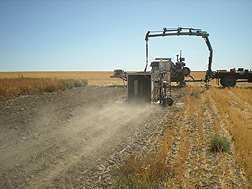No-Till Crops Can Improve Air Quality in the Pacific Northwest
|
|
For more than 100 years, farmers in the Pacific Northwest interior have favored winter wheat/summer fallow production systems. Since rain typically falls during the mild winters, this schedule gives the growing crops the water they need when they need it. But this rotation can require up to eight tillage passes during the fallow season to control weeds and conserve soil water. Tillage also creates a dry, loose bed of fine soil particles that is easily carried away by the strong summer winds.
“In the inland Pacific Northwest, when atmospheric levels of PM10—particulate matter that is 10 microns or less in diameter—exceed federal limits, it’s usually because of erosion from farm lands,” says Agricultural Research Service scientist Brenton Sharratt. He is the research leader in the ARS Land Management and Water Conservation Research Unit in Pullman, Washington. “Since the U.S. Environmental Protection Agency regulates air quality, farmers in this area are looking for ways to reduce erosion from their fields and assist communities in complying with regulations.”
To help address these concerns, Sharratt, ARS agronomist Frank Young, and Washington State University research associate Gary Feng conducted an 11-year study that evaluated whether no-till spring cereal rotations could help mitigate wind erosion. The systems they studied included the typical winter wheat/summer fallow rotation, a no-till spring barley/spring wheat rotation, and a no-till spring wheat/chemical fallow rotation. During the study, they tracked several soil characteristics, including aggregation, moisture, roughness, crusting, and crop residue cover.
Soil properties were measured twice during the study: once after sowing spring wheat and once after sowing winter wheat. Soils are most exposed after sowing, and sowing schedules coincide with the seasons when high winds prevail in the Pacific Northwest.
The scientists found that in the spring, soils in spring barley and spring wheat rotations were wetter than soils in traditional winter wheat systems. In late summer, the no-till spring barley rotation also had more standing stubble than the other two rotations. Stubble helps keep soil on the ground and out of the air.
Results from the study highlighted other soil-quality payoffs from using spring wheat/spring barley rotations. Soils had larger and more continuous pore space, higher water-infiltration rates, higher saturated hydraulic conductivity, and higher drainage rates.
Given these findings, the team concluded that annual no-till spring cereal crops could significantly improve water infiltration and retention and help retain crop surface residue in the late summer. Farmers could benefit from improved soil quality—and a reduced risk of wind erosion.
“One major windstorm can generate enough airborne dust to exceed air quality standards for PM10,” Sharratt says. “But annual no-till cereal crops appear to be a viable strategy that farmers can use to control erosion and meet air quality regulations in the Pacific Northwest.” The next challenge is finding ways to make annual no-till crop systems as profitable as the current winter wheat/fallow system.—By Ann Perry, Agricultural Research Service Information Staff.
This research is part of Climate Change, Soils, and Emissions (#212), an ARS national program described at www.nps.ars.usda.gov.
To reach the scientists mentioned in this story, contact Ann Perry, USDA-ARS Information Staff, 5601 Sunnyside Ave., Beltsville, MD 20705-5129; (301) 504-1628.
"No-Till Crops Can Improve Air Quality in the Pacific Northwest" was published in the July 2012 issue of Agricultural Research magazine.







